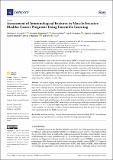Files in this item
Assessment of immunological features in muscle-invasive bladder cancer prognosis using ensemble learning
Item metadata
| dc.contributor.author | Gavriel, Christos | |
| dc.contributor.author | Dimitriou, Neofytos | |
| dc.contributor.author | Brieu, Nicolas | |
| dc.contributor.author | Nearchou, Ines P. | |
| dc.contributor.author | Arandelovic, Oggie | |
| dc.contributor.author | Schmidt, Günter | |
| dc.contributor.author | Harrison, David J. | |
| dc.contributor.author | Caie, Peter D. | |
| dc.date.accessioned | 2021-04-01T09:30:10Z | |
| dc.date.available | 2021-04-01T09:30:10Z | |
| dc.date.issued | 2021-04-01 | |
| dc.identifier | 273354070 | |
| dc.identifier | 0a61b23d-3c1d-4e23-8c7f-a40885579ea9 | |
| dc.identifier | 85103320881 | |
| dc.identifier | 000638357400001 | |
| dc.identifier.citation | Gavriel , C , Dimitriou , N , Brieu , N , Nearchou , I P , Arandelovic , O , Schmidt , G , Harrison , D J & Caie , P D 2021 , ' Assessment of immunological features in muscle-invasive bladder cancer prognosis using ensemble learning ' , Cancers , vol. 13 , no. 7 , 1624 . https://doi.org/10.3390/cancers13071624 | en |
| dc.identifier.issn | 2072-6694 | |
| dc.identifier.other | ORCID: /0000-0001-9041-9988/work/91685661 | |
| dc.identifier.other | ORCID: /0000-0002-0031-9850/work/91685820 | |
| dc.identifier.other | ORCID: /0000-0002-1863-5413/work/91685913 | |
| dc.identifier.uri | https://hdl.handle.net/10023/21752 | |
| dc.description | Funding: This research received financial support from Definiens GmbH and the Industrial Centre for AI Research in digital Diagnostics (iCAIRD) which is funded by Innovate UK on behalf of UK Research and Innovation (UKRI) [project number: 104690]. | en |
| dc.description.abstract | The clinical staging and prognosis of muscle-invasive bladder cancer (MIBC) routinely includes the assessment of patient tissue samples by a pathologist. Recent studies corroborate the importance of image analysis in identifying and quantifying immunological markers from tissue samples that can provide further insight into patient prognosis. In this paper, we apply multiplex immunofluorescence to MIBC tissue sections to capture whole-slide images and quantify potential prognostic markers related to lymphocytes, macrophages, tumour buds, and PD-L1. We propose a machine-learning-based approach for the prediction of 5 year prognosis with different combinations of image, clinical, and spatial features. An ensemble model comprising several functionally different models successfully stratifies MIBC patients into two risk groups with high statistical significance (p value < 1×10−5). Critical to improving MIBC survival rates, our method correctly classifies 71.4% of the patients who succumb to MIBC, which is significantly more than the 28.6% of the current clinical gold standard, the TNM staging system. | |
| dc.format.extent | 9894073 | |
| dc.language.iso | eng | |
| dc.relation.ispartof | Cancers | en |
| dc.subject | Immuno-oncology | en |
| dc.subject | Tumour microenvironment | en |
| dc.subject | Tumour budding | en |
| dc.subject | PD-L1 | en |
| dc.subject | Macrophages | en |
| dc.subject | Lymphocytes | en |
| dc.subject | Prognosis | en |
| dc.subject | survival analysis | en |
| dc.subject | Machine learning | en |
| dc.subject | Digital pathology | en |
| dc.subject | QA75 Electronic computers. Computer science | en |
| dc.subject | QR180 Immunology | en |
| dc.subject | RB Pathology | en |
| dc.subject | RC0254 Neoplasms. Tumors. Oncology (including Cancer) | en |
| dc.subject | NDAS | en |
| dc.subject | SDG 3 - Good Health and Well-being | en |
| dc.subject.lcc | QA75 | en |
| dc.subject.lcc | QR180 | en |
| dc.subject.lcc | RB | en |
| dc.subject.lcc | RC0254 | en |
| dc.title | Assessment of immunological features in muscle-invasive bladder cancer prognosis using ensemble learning | en |
| dc.type | Journal article | en |
| dc.contributor.sponsor | Innovate UK | en |
| dc.contributor.institution | University of St Andrews. School of Computer Science | en |
| dc.contributor.institution | University of St Andrews. Cellular Medicine Division | en |
| dc.contributor.institution | University of St Andrews. Sir James Mackenzie Institute for Early Diagnosis | en |
| dc.contributor.institution | University of St Andrews. School of Medicine | en |
| dc.contributor.institution | University of St Andrews. Centre for Biophotonics | en |
| dc.identifier.doi | 10.3390/cancers13071624 | |
| dc.description.status | Peer reviewed | en |
| dc.identifier.url | https://www.mdpi.com/2072-6694/13/7/1624 | en |
| dc.identifier.grantnumber | TS/S013121/1 | en |
This item appears in the following Collection(s)
Items in the St Andrews Research Repository are protected by copyright, with all rights reserved, unless otherwise indicated.

